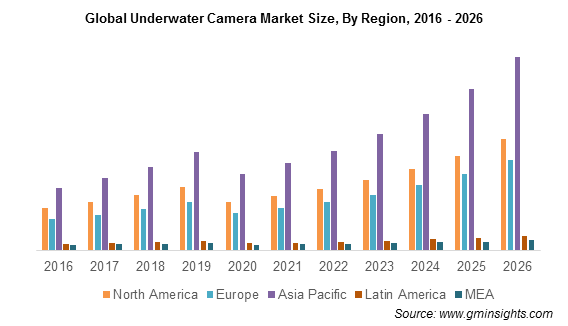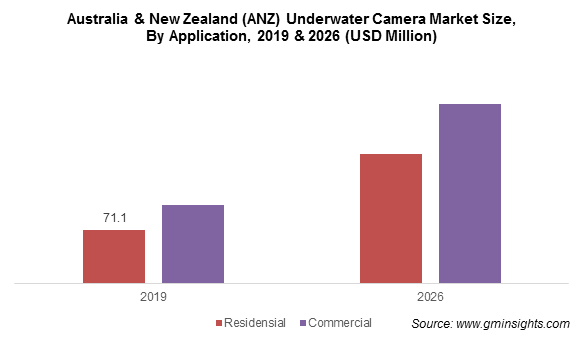Home > Consumer Goods & Services > Consumer Electronics > Underwater Camera Market
Underwater Camera Market Analysis
- Report ID: GMI4803
- Published Date: Aug 2020
- Report Format: PDF
Underwater Camera Market Analysis
The mirrorless underwater camera market will observe growth rate of around 17% through 2026. The absence of mirrors in these cameras enables them to be much lighter and compact compared to DSLRs. The small size of the cameras enhances their portability as travelers can use them conveniently without the hassle of carrying bulky DSLRs. Their small size also creates less drag in the water, enabling to effectively capture fast marine creatures such as marlin. Mirrorless underwater cameras are cheaper than DSLRs, making them a preferred choice for beginner divers searching for budget-friendly and high-quality camera options.
The incorporation of advanced features, such as auto focus systems, high resolution, live preview option, and electronic viewfinder, will fuel the product adoption. Players are focusing on launching advanced underwater mirrorless cameras for allowing users to shoot high-quality pictures and attract large customer base in the market. For instance, in August 2019, Sony Corporation launched its a6100 and a6600 mirrorless digital cameras and interchangeable lens that offer autofocus speed and accuracy solutions for underwater photographers. The ability of mirrorless cameras to capture clear and crisp images even in poor lighting conditions will further support the underwater camera market expansion.
The Australia & New Zealand (ANZ) underwater camera market for the education & research application is estimated to expand at 18% CAGR during the forecast timeframe. As human beings have explored only about 5% of the global oceans, accurate analysis, mapping of underwater habitat, and geological variations have become crucial to researchers over the recent years. They are deploying advanced cameras deep inside the ocean in areas that are difficult to access manually and for consistent monitoring. They can be used to study the behavior of underwater species over a long period of time as well as address phenomena such as volcanic eruptions in the sea.
The Nature Conservancy Australia has installed Reef Cam for monitoring the health of Port Phillip Bay for collecting water quality data in real time. The camera is used for promoting education and awareness about marine life. It supports the annual Great Victorian Fish Count run by the Victorian National Park Association’s Reef Watch Program where remote schools in regions, such as Mildura and Albury, can participate in the event by viewing Reef Cam to educate students about marine life. The increased adoption of innovative cameras for education & research of marine life will propel the underwater camera market demand.
The Europe underwater camera market sales though offline distribution channel will register over 14% growth till 2026. Although there is a sharp rise in online retailing over the recent years, professionals still prefer to buy high-end gadgets from offline stores to ensure product quality and reliability. Specialty stores focusing solely on underwater cameras help consumers to buy products that perfectly suit their individual requirements. They offer personalized services through sales staff appointed in the store that enable consumers to assess a wide range of cameras available. Products sold at proprietary stores also eliminate the risk of fraudulent or duplicate products sold through online retailers, ensuring product durability and reliability.

North America underwater camera market accounted for over 25% of the global revenue share in 2019 owing to the advanced technology landscape in the region, supporting R&D and deployment of high-quality cameras. The U.S. is amongst the earliest adopters of the latest technologies. The acoustic underwater cameras developed by researchers in San Diego, California tracks the remains of vaquita porpoise in the sea of Cortez.
Increasing installations in aquariums as well as natural water bodies will impel the underwater camera market size in North America. The Seattle Aquarium uses the Splashcam range of underwater cameras to educate students. Its six-gill shark research program observes the shark activity in the wild off the Seattle waterfront. The camera provides insights on the behavior of the rare species. Similarly, Ocean Networks Canada’s (ONC) underwater cameras continuously monitor the deep-sea hydrothermal vents, a submarine canyon in the Northeast Pacific Ocean, coastal environments of British Columbia, and the Arctic.

